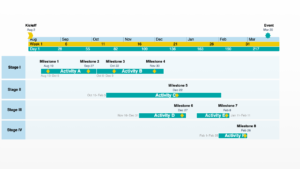Experienced event organisers and those new to the field can learn valuable insights from professionals who know the Request for Proposal (RFP) is a powerful tool in the event planning process.
The RFP identifies suitable venues, food, beverages, and accommodations suppliers, but crafting a comprehensive RFP document can be time-consuming, especially for larger events.
However, tailored RFP templates are a valuable resource that streamlines the process, saving time and enabling you to devote more attention to the creative aspects of event planning.
In this article, we’ll share expert event planning advice acquired over many years of helping event organisers succeed. We’ll propose an eight-step process and provide you with a downloadable RFP template designed to help event organisers maximise their efficiency and deliver exceptional events.
Let’s skip straight to the good stuff and start creating your RFPs.
We’ve crafted the ideal RFP template for you, ready for immediate use for your upcoming event, which you can download for free below.
However, we recommend you take a few minutes to read through the remainder of this guide, particularly the part covering the eight most important sections to include in your RFP and the best practices for drafting them.
You’ll be better positioned to tailor your event planning RFP template to your specific needs.
What is an RFP template?
An RFP template is a pre-built document designed to help project planners and managers create RFPs quickly and consistently.
An RFP (which stands for request for proposal) is a formal document that announces an upcoming project, outlines its details and requirements, and solicits proposals from potential vendors.
In event planning, organisers use RFPs to announce to potential suppliers (such as venues, caterers, or party hire companies) that they’re planning an event and require specific services from outside parties.
For example, you might use an RFP to solicit bids from various local caterers. This would allow you to choose the vendor that offers the most value or the lowest price, depending on your needs.
An event planning RFP template (like the one above) helps event organisers quickly create RFP documents, speeding up the creation process.
Speeding up the creation process is a pretty important goal, considering that, on average, it takes nine people to create a request for a proposal.
Tools like Loopio, an RFP software, can help speed up the RFP creation process for businesses that rely heavily on them for day-to-day operations. For most event planners, however, a solid RFP template will be sufficient to maximise efficiency.
Pro tip: Start with a general template like the one above, then customise it to your business to make the RFP creation process even more efficient.
Why use an RFP template?
Using a template to create RFPs delivers three important benefits for event planners.
1. Efficiency
Using a template to create RFPs increases efficiency by eliminating the need to start from scratch with a new document for each event, saving time and effort in the planning process.
2. Consistency
A template ensures that the RFPs sent out to vendors are consistent. This is particularly beneficial when requesting proposals from the same vendors regularly. With a standardised format, vendors can easily navigate the document and provide relevant proposals.
3. Compliance
For larger event planning teams, using a template helps ensure compliance with internal policies and regulations. For instance, if different team members are responsible for specific aspects like venue sourcing and catering, a template can facilitate adherence to policies, such as identifying potential roadblocks during the planning process.
How to create an RFP: 8 sections to include
Here’s a step-by-step guide to the RFP format that covers all essential sections.
1. Define your event goals and objectives
Begin by outlining the key goals of your event to make it clear to potential suppliers what you’re looking to achieve.
For example, if you are organising an industry conference, the objective could be to increase brand awareness. In the case of a staff retreat, the aim might be to boost morale and foster team-building opportunities.
Event goal-setting is a good practice, but many event organisers struggle to set sufficient objectives. In fact, 37% of projects fail because of a lack of clear goals.
Get super clear on what your objectives are, and then outline them in your RFP document.
This will serve two primary purposes for potential vendors: First, they can assess their ability to support you in reaching your goals. Second, they can construct a tailored proposal and strategic plan to aid in attaining these goals.
Pro tip: While the first section of your RFP is the project overview, it’s easier to write this last once you’ve nailed down the details of your event RFP.
2. Detail the scope of work required
Next, you’ll be detailing the scope (or size) of the project.
The scope section outlines what you require from your supplier in as much detail as possible. Scribd has a great example of a project scope section detailing what to include.
For instance, if you’re looking for a caterer for an event, you might provide details on the following:
- Number of attendees
- Preferred food service style (sit-down, buffet, canapes)
- Food preferences
- Food serving schedule
- Event drink options
The goal is to provide sufficient details for suppliers to create accurate proposals. This enhances alignment between you and your vendors and improves budget accuracy, as they can provide an accurate upfront quote.
Pro tip: Note any significant elements that are outside the scope of the agreement, especially if they are typically included in similar engagements. For example, if you are hiring a caterer solely to provide food and you plan to handle the refreshments separately, this should be specified as an out-of-scope item.

Event Timeline / Source: Office Timeline
3. Specify the event timeline
In this section of your RFP, you’ll provide important information regarding key event timings.
Go beyond simply mentioning the event date — detail critical dates leading up to the event itself. For example, if your event is scheduled for March 20, and you need to have the catering plan locked in by March 1, you should communicate this clearly to prospective vendors.
You may find using a tool like Office Timeline to visualise key dates helpful. This can be an effective way to communicate information to various vendors.
Of course, it’s important to recognise that dates and timelines can change, so you should note in your RFP that these are estimates and subject to change.
No matter how perfectly planned your event timeline is and how closely you stick to it, sometimes things happen that are out of your control. Touching base with your suppliers regularly will keep you in their minds. Check in with the venue about set-up times and confirm delivery slots with your vendors a few days before.
4. Clarify any pre-existing challenges or roadblocks
Outline any roadblocks like resource constraints or timeline challenges.
This helps vendors create a more relevant proposal and even identify opportunities to help you solve them.
For example, you might have only half an hour to serve lunch between speaking events at the corporate event you’re planning, which could present a challenge for caterers. Providing information on these roadblocks upfront allows potential suppliers to plan around them.
Pro advice: Be as specific as possible here. The idea is to eliminate any suppliers that might not be appropriate because of these limitations.
5. Explain how you’ll choose a supplier
The point of issuing an RFP is to help you choose the right vendor for your event. To achieve this, you should define your selection process and supplier selection criteria upfront.
This might include, for example:
- The supplier’s track record of success
- Total costs involved in contracting the vendor
- Conducting a supplier credit check
Once you’ve clearly established these criteria, communicate them as part of your RFP.
This will help potential vendors self-disqualify if needed and allow them to hone their proposal to be as relevant as possible.
6. Describe how you’ll measure success
You’ve outlined how you plan to select vendors. Now let them know precisely how you intend to measure the success of your event. Specifically, discuss how you plan to measure the impact of their part in it.
By setting expectations up front, potential vendors will understand how they can tailor their service offerings to help you meet your goals.
Eventbrite’s event management software is the perfect companion here. Our event management dashboard helps you measure key event metrics like ticket sales and share this data with relevant vendors to deliver on the expectations you set for success measurement in your RFP.
Measurement, management, and planning at your fingertips

7. Provide an estimate of your budget
The proposal you receive from each supplier will include a summary of the costs involved. By sharing an estimated budget with suppliers, you establish expectations and provide a pricing anchor.
Prospective vendors who would charge much more than you have budgeted for will weed themselves out, and you’ll receive much more relevant proposals rather than a ton of different price points.
If you’ve not yet solidified a budget for this specific engagement, you can use our free event budgeting template to calculate one.
8. Write a project overview
Lastly, return to the first section of your RFP document: the overview.
The overview section concisely summarises everything you cover below in the RFP, so it’s best to write this last once you’re clear on all the details.
Keep this section concise. A good rule of thumb is to stick to one sentence per section of the RFP.
The idea here is to enable readers to quickly determine whether the event or project is appropriate for them and decide whether or not they should read on.
Expert tip: Sell the dream and make it exciting! You want these vendors to be as stoked to work on your event as you are!
Use an RFP template to simplify your events
RFPs are a crucial component of the event planning process.
They can, however, be time-consuming, which is why a good RFP template can be a powerful companion for anybody organising an event.
Grab our free RFP template for event organisers here!
Of course, the RFP is just one step in the event organisation process. Eventbrite’s event platform is designed specifically to support event planners like you throughout organising and running an event.






